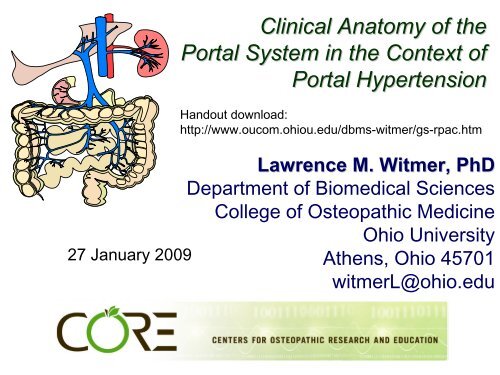Clinical anatomy in the context of portal hypertension.
Clinical anatomy in the context of portal hypertension.
Clinical anatomy in the context of portal hypertension.
Create successful ePaper yourself
Turn your PDF publications into a flip-book with our unique Google optimized e-Paper software.
27 January 2009<br />
<strong>Cl<strong>in</strong>ical</strong> Anatomy <strong>of</strong> <strong>the</strong><br />
Portal System <strong>in</strong> <strong>the</strong> Context <strong>of</strong><br />
Portal Hypertension<br />
Handout download:<br />
http://www.oucom.ohiou.edu/dbms-witmer/gs-rpac.htm<br />
Lawrence M. Witmer, PhD<br />
Department <strong>of</strong> Biomedical Sciences<br />
College <strong>of</strong> Osteopathic Medic<strong>in</strong>e<br />
Ohio University<br />
A<strong>the</strong>ns, Ohio 45701<br />
witmerL@ohio.edu
Portal System<br />
• Conducts venous return from<br />
gut and associated organs to<br />
<strong>the</strong> liver<br />
• Much <strong>of</strong> <strong>the</strong> system is<br />
retroperitoneal but some<br />
tributaries are with<strong>in</strong><br />
mesentery<br />
from Netter 1957
Portal System<br />
(extrahepatic tributaries)<br />
Portal ve<strong>in</strong><br />
• Superior mesenteric V.<br />
• Intest<strong>in</strong>al ve<strong>in</strong>s<br />
• Ileocolic ve<strong>in</strong><br />
• Right colic ve<strong>in</strong><br />
• Middle colic ve<strong>in</strong><br />
• Inferior pancreaticoduodenal<br />
• Right gastroepiploic ve<strong>in</strong><br />
• Splenic ve<strong>in</strong><br />
• Inferior mesenteric ve<strong>in</strong><br />
• Left colic ve<strong>in</strong><br />
• Sigmoid ve<strong>in</strong>s<br />
• Superior hemorrhoidal ve<strong>in</strong>s<br />
• Pancreatic ve<strong>in</strong>s<br />
• Left gastroepiploic ve<strong>in</strong><br />
• Short gastric ve<strong>in</strong>s<br />
• Coronary ve<strong>in</strong><br />
• Cystic ve<strong>in</strong><br />
• Paraumbilical ve<strong>in</strong>s<br />
from Netter 1957
Portal System<br />
variations<br />
• Variations are relatively rare<br />
• Length <strong>of</strong> ma<strong>in</strong> <strong>portal</strong> stem : 55-80 mm<br />
• Diameter: 11 mm, more <strong>in</strong> cirrhosis<br />
• Ma<strong>in</strong> variations <strong>in</strong>volve connections <strong>of</strong><br />
gastric coronary ve<strong>in</strong> and IMV<br />
anomalies<br />
• Anomalies are rare<br />
• Anterior position <strong>of</strong> <strong>portal</strong> ve<strong>in</strong> relative<br />
to pancreas and duodenum<br />
• Portal ve<strong>in</strong> bypass<strong>in</strong>g liver and dra<strong>in</strong><strong>in</strong>g<br />
<strong>in</strong>to IVC<br />
from Netter 1957
Portal Hypertension<br />
Etiology<br />
• Classification systems<br />
• Pres<strong>in</strong>usoidal, s<strong>in</strong>usoidal, posts<strong>in</strong>usoid.<br />
• Extrahepatic vs. <strong>in</strong>trahepatic<br />
• Suprahepatic, <strong>in</strong>trahepatic, <strong>in</strong>frahepatic<br />
• Suprahepatic (outflow obstruction)<br />
• Right-side heart failure, constrictive<br />
pericarditis, Budd-Chiari syndrome<br />
• Often <strong>portal</strong> <strong>hypertension</strong> is matched<br />
by systemic (caval) <strong>hypertension</strong>s<br />
• Intrahepatic (90% <strong>of</strong> cases)<br />
• Cirrhosis most common but o<strong>the</strong>rs too<br />
• Typical pathologic anatomical f<strong>in</strong>d<strong>in</strong>gs<br />
• Infrahepatic<br />
• Obstruction <strong>of</strong> extrahepatic <strong>portal</strong><br />
system<br />
• Portal (or splenic) v. thrombosis<br />
• Cavernomatous transformation <strong>of</strong> <strong>portal</strong><br />
ve<strong>in</strong><br />
• Tumor, <strong>in</strong>fection, compression<br />
• Typical pathologic anatomical f<strong>in</strong>d<strong>in</strong>gs<br />
from Netter 1957
Vascular Changes<br />
<strong>in</strong> Cirrhosis Lead<strong>in</strong>g to<br />
Portal Hypertension<br />
• Compression <strong>of</strong> hepatic ve<strong>in</strong>s<br />
• Regen. nodules and connective<br />
tissue septa compress ve<strong>in</strong>s<br />
• Decreased outflow, <strong>in</strong>creased<br />
upstream <strong>portal</strong> pressure<br />
• Formation <strong>of</strong> portahepatic AVAs<br />
• Direct anastomoses between<br />
hepatic a. branches and <strong>portal</strong><br />
ve<strong>in</strong> tributaries<br />
• Increased flow <strong>in</strong>to <strong>portal</strong><br />
system via AVAs <strong>in</strong>creases<br />
<strong>portal</strong> <strong>hypertension</strong><br />
from Netter 1957
Pathological Anatomy<br />
Associated with<br />
Portal Hypertension<br />
• Esophageal varices<br />
• Splenomegaly<br />
• Caput medusae<br />
• Ascites<br />
from Netter 1957
Portacaval Anastomoses<br />
• Esophageal anastomosis: azygos (caval) — coronary or short<br />
gastric (<strong>portal</strong>)<br />
• Paraumbilical anastomosis: paraumbilical vv. (<strong>portal</strong>) —<br />
epigastric vv. (caval)<br />
• Rectal anastomosis: sup. hemorrhoidal (<strong>portal</strong>) — <strong>in</strong>f. &<br />
middle hemorrhoidal vv. (caval)<br />
• Retroperitoneal anastomosis: visceral vv. <strong>of</strong> Retzius (<strong>portal</strong>) —<br />
parietal vv. (caval)<br />
from Netter 1957<br />
From Moore & Dalley 2006
Rectal Anastomosis:<br />
Hemorrhoids <strong>in</strong> Portal Hypertension?<br />
Sup. hemorrh. vv. (<strong>portal</strong>) — <strong>in</strong>f. & mid. hemorrh. vv. (caval)<br />
middle rectal v.<br />
superior rectal v.<br />
<strong>in</strong>ferior rectal v.<br />
from Netter 1962<br />
From Fry & Kodner (1985) CIBA
Paraumbilical Anastomosis:<br />
Caput medusae<br />
Paraumbilical vv. (<strong>portal</strong>) —<br />
Superficial, superior, & <strong>in</strong>ferior epigastric<br />
vv. (caval)<br />
from Netter 1957<br />
From Moore & Dalley 2006
Retroperitoneal Anastomosis:<br />
Ascites<br />
Visceral vv. <strong>of</strong> Retzius (<strong>portal</strong>) —<br />
Retroperitoneal parietal vv. (caval)<br />
From Moore & Dalley 2006<br />
from Netter 1957
from Netter 1959<br />
Esophagogastric Anastomosis:<br />
Varices<br />
Azygos (caval) — Coronary or<br />
short gastric (<strong>portal</strong>)
References<br />
• Fry, R. D. and I. J. Kodner. 1985. Anorectal disorders. CIBA <strong>Cl<strong>in</strong>ical</strong> Symposia 37(6):1-32.<br />
• Moore, K. L. and A. F. Dalley. 2006. <strong>Cl<strong>in</strong>ical</strong>ly Oriented Anatomy, 5th Ed. Lipp<strong>in</strong>cott,<br />
Williams & Wilk<strong>in</strong>s, Baltimore.<br />
• Netter, F. H. 1957. The CIBA Collection <strong>of</strong> Medical Illustrations, Volume 3: Digestive<br />
System, Part III. CIBA-Geigy, Summit.<br />
• Netter, F. H. 1959. The CIBA Collection <strong>of</strong> Medical Illustrations, Volume 3: Digestive<br />
System, Part I. CIBA-Geigy, Summit.<br />
• Netter, F. H. 1962. The CIBA Collection <strong>of</strong> Medical Illustrations, Volume 3: Digestive<br />
System, Part II. CIBA-Geigy, Summit.

















